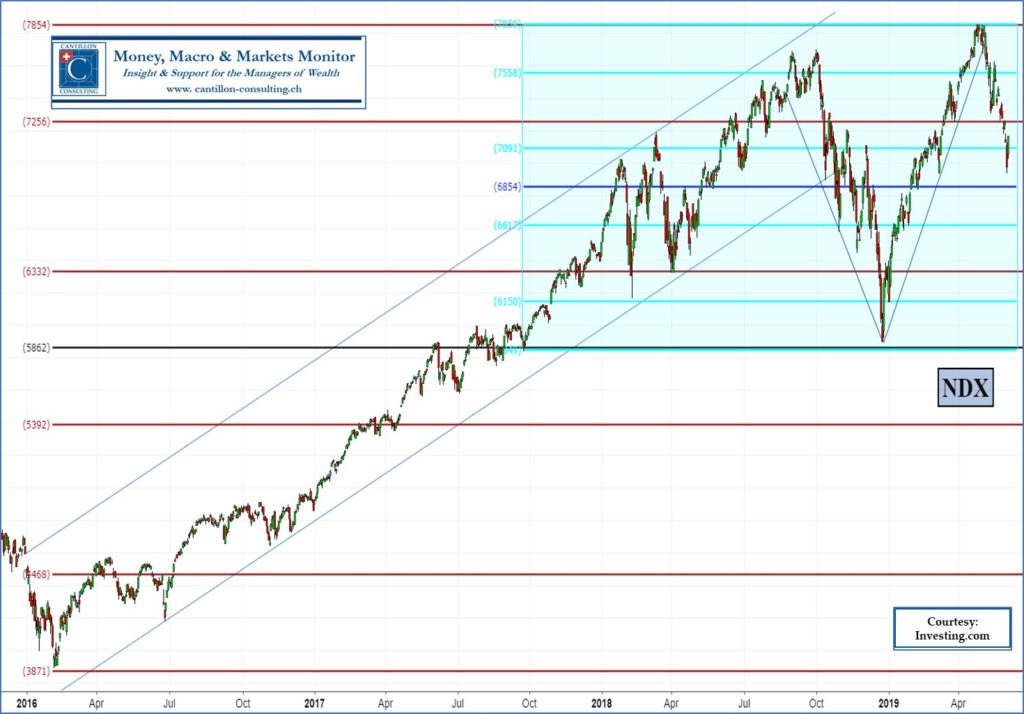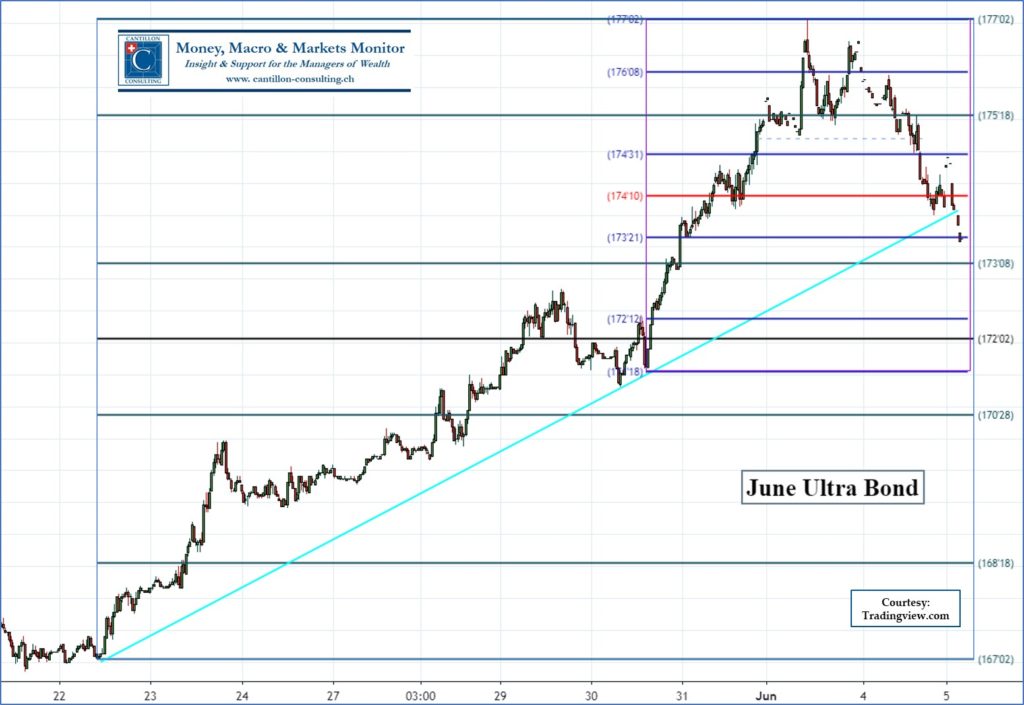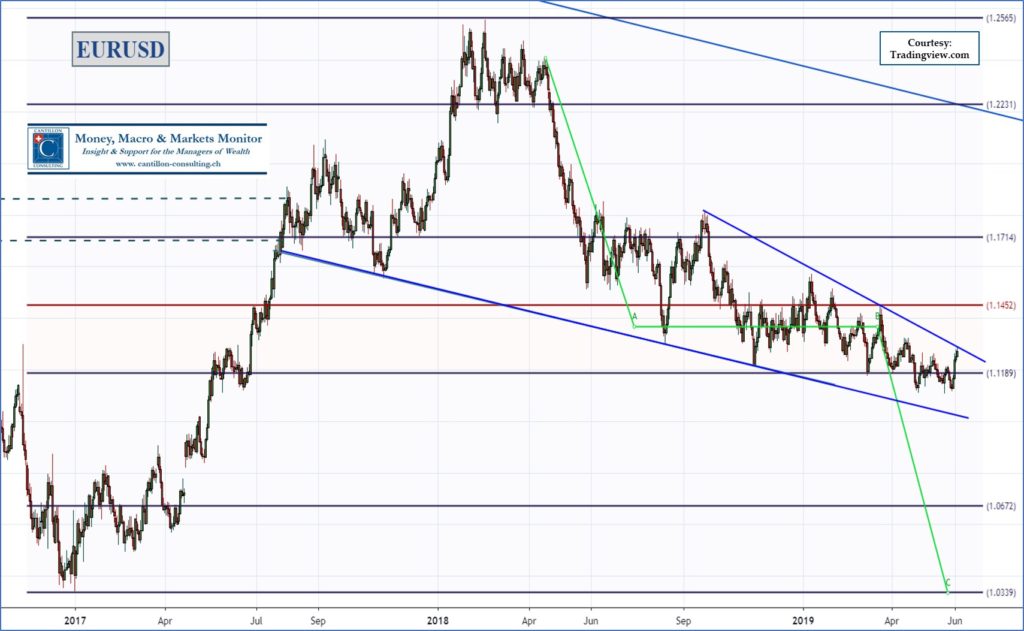After the excitement of the past few sessions, it was not entirely unexpected that what we old market stagers used to call, ‘Turnaround Tuesday’, would deliver its traditional mix of reflection, position rebalancing, and general counter-trend moves of either the stop-profit or the ‘Why do I always buy the top?’, buyers’ regret kind. [First Published June 4th]
As is becoming all too standard these days, a Presidential tweet was to be found near the scene of the crime, with Mr. Trump taking time off from his sightseeing trip to London to deliver one of those 280-character cryptic flip-flops on the Trade War which briefly ignites alternating flashes of hope or despair in the Great Jobbing Public.
It was said that when he was first manipulating the gold value of the newly devalued dollar back in the early 1930s, Roosevelt would pick some random number out of the air and instruct Treasury Secretary Morgenthau to enact it, all while taking his customary breakfast egg in bed.
We cannot say for sure whether POTUS 45 is a cooked breakfast man or not – and the technology for carrying out the Executive whim has certainly moved on apace – but there are undoubted parallels in the sheer egotistical caprice involved in conducting policy in this manner.
The added catalyst for unwinding some good part of the past few sessions’ moves came from a speech given by Fed Chairman, Jay Powell, when he opened a conference which looks set to give a formal hearing to every crank monetary and hyper-academic calculus-crunching wheeze for trying to keep an overindebted populace still merrily spending, come what may.
Powell himself gave a clear demonstration of the Carrollean Wonderland into which the toleration of such assaults on good common sense have led us with a rehearsal of that canard of the dangers of not having continual rises in prices with which to erode the value of people’s income and savings.
For example:-
“…over time, inflation has become much less sensitive to tightness in resource utilization. This insensitivity can be a blessing in avoiding deflation when unemployment is high, but it means that much greater labour market tightness may ultimately be required to bring inflation back to target in a recovery. Using monetary policy to push sufficiently hard on labour markets to lift inflation could pose risks of destabilizing excesses in financial markets or elsewhere.” [Emphasis mine]
What he is saying here is that there might, after all be a price to be paid if the blessings of full employment, rising output, and increased productivity are not to be allowed to manifest themselves in a wholly welcome and utterly benign fall in unit prices, but are instead to be prevented from doing so in pursuit of the dominant fetish of modern central bank orthodoxy – namely, that prices should always rise by around 2% per annum. The conditional tense – this ‘could’ pose risks – is also ironic in that it was exactly such a policy which led to the Crash of ’29, the Tech Bubble of 2000, and – above all, the CDS-mortgage-wholesale banking collapse of 2008.
Unspoken, too, is the fact that this perverse policy – nowadays pursued at the cost of visiting every greater violence upon not just the allocation of capital but the very structure of society itself – stands in complete opposition to the intent of those who originally adopted it as a convenient and readily intelligible red-line through which inflation should not rise, as a means of keeping control over those inveterate Keynesian inflationists who dominated the governments of the 80s and 90s.
All this is bad enough. It is one thing to fret that prices occasionally do not go up as fast as the central banking shamans might wish, but Powell then went on to give a tacit seal of approval to the PhD Economists’ extension of this to ensuring not just that the pace is rapidly picked up again when once it has lagged, but that prices should be driven to regain their former trajectory – an idea so innately lunatic that it would be at home in the pages of ‘Gulliver’s Travels’.
Let us hand the floor back to Chairman Powell:
“…[this] raises the issue of whether the FOMC should use makeup strategies… Suppose that a spell with interest rates near the Effective Lower Bound [the point below which it is impractical to reduce them further] leads to a persistent shortfall (!) of inflation …what if the central bank promised credibly that it would deliberately make up for any lost inflation by stimulating the economy and temporarily pushing inflation modestly above the target?”
“In the models…” – Models! As Hamlet would say, ‘Aye, there’s the rub!’ – “…the prospect of future stimulus promotes anticipatory consumption and investment that could greatly reduce the pain of being at the lower bound”
“For makeup strategies to work, households and businesses must go out on a limb, so to speak, raising spending in the midst of a downturn. In theory, they would do this based on their confidence [their abiding fear?] that the central bank will deliver the makeup stimulus at some point—perhaps years in the future …But important questions remain. To achieve buy-in by households and businesses, a comprehensible, credible, and actionable makeup strategy will need to be followed by years of central bank policy consistent with that strategy.” [Emphasis mine]
Now, this may all sound highly abstract and even hypothetical, but note that Powell is saying that for this madness to take root, the groundwork must be laid well in advance of its implementation, meaning, Dear Reader, than you can expect central banks to build this into their every utterance, every projection, and every policy decision from now on. Moreover, our esteemed Fed Chairman confessed that he fully expected that such a set of circumstances will one day come about and so “…the next time policy rates hit the ELB [Lower Bound] – and there will be a next time—it will not be a surprise.“
What this also means is that, should some temporary undershoot arise – despite the central banking cabal’s concerted efforts to head off this ‘calamity’ – people will have to steel themselves for a protracted period of overshoot thereafter. To put this in concrete terms, if you find the good folks at Carrefour are today selling you butter at €1.60 per 250g instead of the usual €1.80, you should contain your joy because, by law, they will have to charge €2.00 the next time you shop there!
For now, this kind of talk was enough to restore a little enthusiasm for risk assets and – ipso facto – diminish the safe haven appeal of their polar opposites.
The VIX ‘fear gauge’ of stock market volatility dipped from Monday’s 3-week high of 19.7% to just over 17%. Tech stocks – which had fallen 11% in a month – finally based and put in a brave, little 3% rally. Ultra-long Treasury futures surrendered 3 of the impressive 10 big figures they gave added in the past 8 trading session, adding 8 basis points to their underlying yield. The Euro, having spent a nervous few days flirting with a break through $1.1100 which would have set new, 2-year lows, bounced to a three-week high of $1.1275.
Where does that leave markets? Whipsawed, as usual and anxiously waiting to see if the Donald has time between the first course of heritage tomatoes with fresh burrata and garden basil and the main consisting of grilled filet of beef with pommes Anna, which he is taking with Prince Charles and their good lady wives, to tweet something which will give it its next momentary impetus.
Efficient markets? Who needs’em?
Postscript: JayPowell says if the increase in CPI undershoots, the Fed will henceforth try to ensure it overshoots, pari passu.
But if I know that policy will always home in on the initially chosen, ‘ideal’ price trajectory why would I buy bonds or lend money at any other interest rate than the one which incorporates this, so maintaining my desired real returns?
Ergo, that real rate will RISE amid the slowdown which Powell is so anxious to avoid. It will also FALL during his period of super-inflationary ‘make-up’ and so it will prove unhelpfully counter-cyclical in each of the two scenarios. DOH!
Given that the former is the situation about which Keynes fretted – albeit one then predicated upon a highly unlikely bout of unshakable ‘anchoring’ being suffered by his fellow ‘college bursars’ (men whom he took pains to disparage in his usual supercilious fashion) – a policy of CPI ‘make-up’ all but GUARANTEES that we at last get to see that heretofore mythical beast, the ‘Liquidity Trap’, emerge from its long confinement in the dark imaginings of mainstream Macromancers and actually make its first appearance in the wild.
Nice one, Jay!



